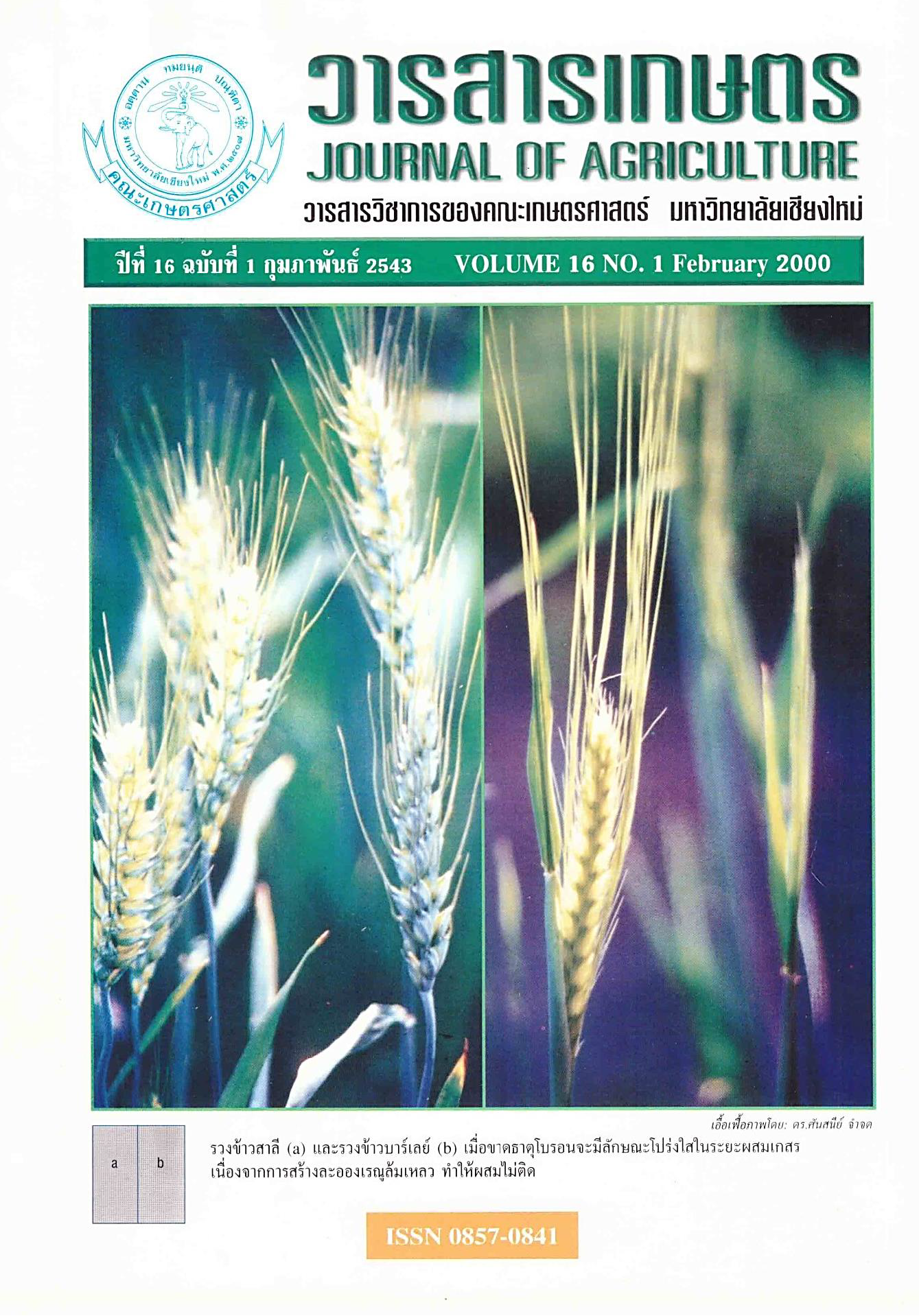ผลของระดับกากเบียร์แห้งในอาหารต่อผลผลิตและองค์ประกอบของน้ำนมในโคนมพันธุ์โฮลสไตน์ฟรีเชียน
Main Article Content
บทคัดย่อ
การทดลองครั้งนี้มีวัตถุประสงค์เพื่อศึกษาผลของระดับกากเบียร์แห้ง (dried brewers grains, DBG) ต่อสมรรถภาพการให้ผลผลิตของโคนม โดยใช้โคนมพันธุ์โฮลสไตน์ฟรีเชียนในระยะรีดนม จำนวน 24 ตัวอายุประมาณ 4-5 ปี น้ำหนักเฉลี่ย 472±11 กก. ใช้แผนการทดลองแบบ Randomised complete block design (RCBD) โดยใช้ช่วงการรีดนมเป็นบล็อคมี 2 บล็อค ได้แก่ ช่วงแรก และช่วงกลางของการรีดนมประกอบด้วยอาหารทดลอง 4 กลุ่ม คือ ใช้กากเบียร์แห้ง 0% (0% DBG) กากเบียร์แห้ง 10% (10% DBG) กากเบียร์แห้ง 20% (20% DBG) และกากเบียร์แห้ง 30% (30% DBG) คิดเป็นวัตถุแห้งในอาหารข้น ผลการทดลองพบว่าปริมาณการกินได้ คิดเป็นกรัม/น้ำหนักตัว0.75 กลุ่ม 109% DBG และ 20% DBG สูงกว่า (p<0.05) กลุ่ม 30% DBG และมีความสัมพันธ์กับระดับกากเบียร์แห้งแบบเส้นโค้ง (p<0.02) การย่อยได้ของวัตถุแห้งและอินทรีย์วัตถุ ลดลงตามระดับกากเบียร์แห้งที่เพิ่มขึ้น (quadratic<0.01, cubic p<0.03) กลุ่มที่ใช้กากเบียร์แห้ง 20 เปอร์เซ็นต์ ให้ผลผลิตน้ำนมสูงกว่า กลุ่มที่ใช้กากเบียร์แห้ง 10% (18.7 และ 18.4 กิโลกรัม ตามลำดับ ที่ p<0.05) และทั้งสองกลุ่มสูงกว่า กลุ่มที่ใช้กากเบียร์แห้ง 0% และ 30% (15.95 และ 15.90 กิโลกรัม ตามลำดับที่ p<0.05) ส่วนเปอร์เซ็นต์ของโปรตีน และไขมันในน้ำนมกลุ่ม 20% DBG และ 30% DBG สูงกว่ากลุ่มอื่น (p<0.05) ดังนั้นการใช้กากเบียร์แห้งในสูตรอาหารโคนมในระดับ 20% ในสูตรอาหารให้ผลตอบแทนทางเศรษฐกิจสูงกว่ากลุ่มอื่น และมีแนวโน้มลดลงเมื่อเพิ่มกากเบียร์แห้งสูงถึง 30% ในสูตรอาหาร
Article Details
เอกสารอ้างอิง
สาโรช ค้าเจริญ. 2542. อาหารและการให้อาหารสัตว์เลี้ยง. ภาควิชาสัตวศาสตร์ คณะเกษตรศาสตร์ มหาวิทยาลัยขอนแก่น.
A.0.A.C. 1985. Official Methods of Analysis. Association of Official Analytical Chemists. Washington, D.C. 1158 p.
A.O.A.C. 1990. Official Methods of Analysis. Association of Official Analytical Chemists. 15th Ed. Verginia, USA. 1298 p.
Cullison, A.E. 1979. Feed and Feeding. Reston Publishing Company Inc., Virginia, USA. 657 p. Davis, C.L., D.A. Grenawalt and G.C. McCoy. 1982. Feeding value of pressed brewers grains for lactating dairy cows. J. Dairy Sci. 66: 73-79.
Goering, H.K., and P.J. Van Soest. 1970. Forage Fiber Analysis (Apparatus, Reagents, Procedures and Some Application). Agric. Handbook No. 379, ARS, USDA Washington, D.C.
Gohl, B. 1978. Tropical Feed. F.A.O., Rome. Italy. 125 p.
National Research Council. 1988. Nutrient Requirement of Dairy Cattle. National Academy Press. U.S.A. 115 p.
National Research Council. 1996. Nutrient Requirement of Beef Cattle. National Academy Press. U.S.A. 242 p.
Polan, C.E., T.A. Herrington, W.A. Waller and L.E. Armentend. 1984. Milk production response to diets supplemented with dried brewers grains, wet brewers grains or soybean meal. J. Dairy Sci. 68: 2016.
Porter, R.M. and H.R. Conrad. 1975. Comparative nutritive value of wet and dried brewers grain for dairy cattle. J. Dairy Sci. 58: 747. (Abstr.)
Preston, R.L., R.D. Vance and V.R. Cabill. 1973. Energy evaluation of brewers grains for growing and finishing cattle. J. Anim. Sci. 37: 174.
Rounds, W. and T. Klopfenstein. 1975. Brewers dried grains in ruminant rations. J. Anim. Sci. 41: 415. (Abstr.) 5.
SAS. 1985. User's Guide: Statistics. Versions 5. Edition SAS. Inst. Cary, NC.
Schnieder, B.H. and W. P. Flatt. 1975. The Evaluation of Feed through Digestibility Experiment Athens The Univ. of Georgia Press. Georgia, USA.
Steel, R.G.D. and J.H. Torries. 1980. Principles and Procedures of Statistics a Biometereal Approach. 2nd ed., McGrow-Hill. New York:U.S.A. 1564 p.
Van Horn, H.H. and D.R. Jacobson. 1971. Response of lactating cows to added increments of dietary protein and non-protein nitrogen. J. Dairy Sci. 54:379.
Van Keulen, J. and B.A. Young. 1977. Evaluation of acid soluble ash as a neutral marker in ruminant digestibility studies. J. Anim. Sci. 44:282.


